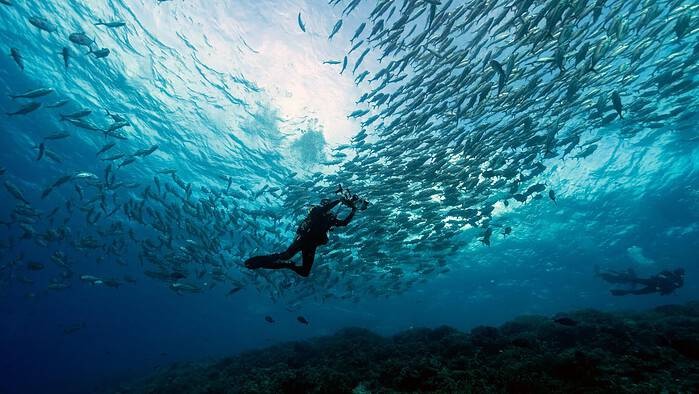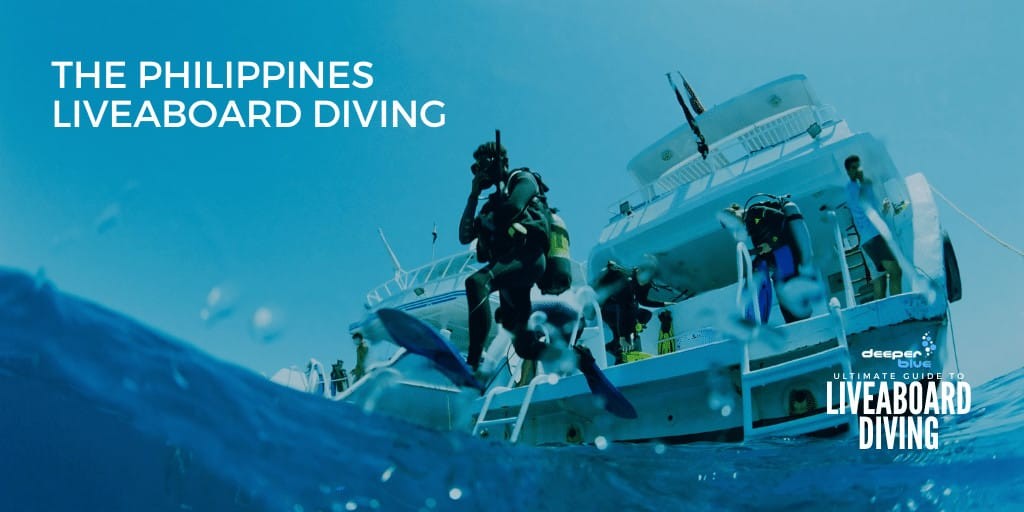Philippines Liveaboard Diving is part of the Ultimate Guide to Liveaboard Diving
This page contains references to products from one or more of our advertisers. We may receive compensation when you click on links to those products. For an explanation of our Advertising Disclosure Policy, visit this page.
With an abundant ecosystem, a variety of about 2000 species of fish, and 7,107 islands, liveaboard diving in the Philippines remains at the top of any diver’s bucket list. If it’s not added yet, perhaps it’s time to consider adding it as another liveaboard adventure destination to visit!
Apart from the year-round warm climate, pristine beaches, and crystal blue waters, a Philippines Liveaboard offers a variety of dive sites that span from exploring historic wrecks to marveling at corals and marine encounters, from tiny critters to pelagic marine life!
The Philippines Liveaboard Routes
With over 7000 islands mapping out The Philippines, there are some spectacular routes to explore by a Philippines Liveaboard.
Malapascua
6.8km off the northern tip of Cebu, you will find the tiny island of Malapascua; this island only contains a landmass of 3 square kilometers, and it is the only destination in the world where you can encounter elusive thresher sharks daily. The surrounding waters of Malapascua host over twenty dive sites, which makes it an annual dive destination for divers to return to.
Check prices for Malapascua Itinerary Liveaboards
Some of the more popular dive sites of Malapascua to explore by liveaboard are:
- Monad Shoal – Monad shoal is the Malapascua core dive site; characterized by a submerged island sitting on the edge of a steep drop-off, this location attracts the natives of the deep such as threshers, mantas, devil rays, and on the chosen occasion, other species of sharks. The main thresher dive sites of Malapascua are Shark Point and Shark Wall.
- Gato Island – Here, you will find up to five unique dive sites which present a variety of critters from big to small! At The Guardhouse, you can encounter pygmy sea horses; the dive site Whitetip Alley is a haven for sleeping whitetip sharks and macro life. The Cave is an advanced and daring dive with a 30-meter tunnel brimming with swimming or resting sharks. Here you can expect some close encounters; at Catherdral, you will also find white tips among beautiful rock formations and Nudibranch City, a haven for any nudibranch enthusiast!
- Kimud Shoal – This is Malupascuas hammerhead dive site. Kimud shoal is near Monad shoal and shares the same characteristics due to their steep drop-offs. Hammerhead season is from December to May, and if you plan to visit in April, you can see shivers of hammerheads in great numbers! This dive site also allows you to encounter threshers and manta rays! Aside from the giants on this dive site, Kimud Shoal is characterized by hard corals at the top, soft corals, macro life, and overhangs.
- Lighthouse – Lighthouse is ideal for dusk and night dives! This dive site offers an opportunity to encounter mandarin fish reliably; you can even see them mating on that lucky dive! Invertebrates like squid, cuttlefish, nudibranchs, octopus, and seahorses make it the perfect site for macro lovers.
More of Malapascua
Apart from reliable sites for sharks, mantas, and big pelagics, there are a few more dive sites that are not to be missed:
- Lapus Lapus island: is where you can marvel at the pristine hard and soft coral reefs or muck diving in
- Bantigi: This is great for muck diving!
- Dona Marilyn: It is a wreck where you can encounter benthic rays and white-tip sharks.
- Tapilon: A Japanese wreck that got sunk by a torpedo from WW2, which is accompanied today by black coral bushes, nudibranchs, flatworms, and white marble rays.
Tubbataha Reefs
The Tubbataha reefs are also a marine protected area and a UNESCO World Heritage site. Being a remote location and only accessible via liveaboard for a little over three months a year, the Tubbataha Reefs is one of the world’s healthiest and least exploited reefs!
This pristine reef system is made up of 100,000 hectares and divided into three key areas: Jessy Beazley Reef, North Atoll, and South Atolls.
Check prices for Tubbatha Itinerary Liveaboards
Taking The Tubbataha Reefs root, you can explore various key dive sites across the reef, such as:
- Amos Rock – This is home to an array of corals, gorgonian fans, and larger fish species like snappers, groupers, mackerel, and Napoleon wrasses. You can also encounter various reef sharks, and the night diving here will be the perfect opportunity to encounter macro species.
- Washing Machine – If manta rays and sharks are on your bucket list, the Washing machine is the perfect dive site on the North Atoll to glide with the current and encounter some marine megafauna.
- Malayan Wreck – Malayan Wreck offers the best of both for adventurous wreck exploration and looking out for macro life like nudibranchs, shrimps, and crabs.
- Shark Airport – If you aim to encounter sharks in the Philippines, then Shark Airport is a site not to be missed! Here you will find sharks passing by or resting on the reef.

Bohol
Explore Bohol by liveaboard, and beautiful drop-offs, vibrant soft and hard corals, macro life, and bigger pelagics will meet you!
Check prices for Bohol Itinerary Liveaboards
The Bohol route offers four main diving areas:
- Anda – Anda offers caves, steep underwater cliffs, and coral gardens to explore. You can expect to encounter a miscellany of macro life, including sea horses and migrating whale sharks.
- Pangla – Panglao reef is teeming with soft coral and brimming with turtles, glass fish, sea snakes, and giant frogfish. On the chosen day, you could encounter a manta ray or whale shark passing by!
- Balicasag Island – 10km southwest of Panglao, you will find the breathtaking Balicasag Island. Balicasag Island consists of four main dive sites; the Black Forest, Divers’ Heaven, Cathedral Garden, and Balicasag Sanctuary. Balicasag island is a diverse dive site where you will have the opportunity to encounter an abundance of fish life varying from big to minor as well as a burst of color made up of soft and hard corals, as well as sponges.
- Pamilican – Pamilican is notorious for its diversity of pelagic fish and crystal visibility. Greater pelagics such as dogtooth tuna, trevally, and schools of barracuda are common sightings here, and on a lucky day, you can even encounter dolphins or whales on a dive!
Best Time Of Year For A Philippines Liveaboard
The Philippines is a year-round destination; however, the best diving season is during the dry season, which falls between December – May.
The water is at its warmest, and the visibility is excellent!
Marine Encounters While On A Philippines Liveaboard
With bigger animals, sharks, rays, macro life, and vibrant underwater characteristics, there is something for any diver in The Philippines.
Big animals you can encounter are thresher sharks (Monad shoal), manta rays, whale sharks, a variety of turtle species, and schools of pelagic fish such as barracudas, tuna, and jacks.
You can encounter macro life in The Philippines, including various nudibranch species, frogfish, colorful shrimp, and seahorses.
Types Philippines Liveaboards
You will find three main types of liveaboard vessels in the Philippines: expedition-style boats, luxury single-hull motor yachts, and wooden sailing boats, and on occasion, you will even find traditional Bangka trimaran boats that are a more budget-friendly option.
Whichever type of liveaboard you decide on, you can be assured that you are in for a great trip around the islands. All vessels include lounge decks, shaded outside areas, in and outside dining areas, comfortable cabins, and a well-set-up dive deck.
Check prices for Philippines Liveaboards
Cuisine Onboard An Philippines Liveaboard
On board, you can expect to be treated to delicious local Filipino cuisine and some western orientated cuisine.
How Many Dives A Day?
Usually, you will do three dives a day; on some days, there will be an optional night dive.
Dive Certification Requirements
The Philippines welcomes divers of all levels; in most places, diving is easy and accessible for novice divers, and some liveaboards are even snorkeler friendly!
For divers with an advanced or equivalent certification, dive sites like deeper reefs, drop-offs, and drift dives are more demanding.
Bring your certification card if you are nitrox certified as some Philippines liveaboards offer nitrox.
Other Useful Information For Philippines Liveaboard Diving
Entry Into The Philippines
The airport that you fly into will depend on which liveaboard route you choose to take. To enter The Philippines as a tourist, ensure you have a valid passport for at least six months after arriving and have proof of an onward or outbound airline ticket.
Occasionally, you must pay terminal fees at the airport in local currency; contact your liveaboard agent about this before your trip to ensure you have enough cash if needed.
Currency
The local currency in the Philippines is the Philippine peso or Piso in Filipino. You can exchange your local currency for Philippine pesos at the airport or an exchange bureau; take note that there are islands where paying with a credit card or withdrawing cash could be a problem, so make sure you have enough cash in Filipino currency for the duration of your stay.
Getting Around
Transfers are often included in your liveaboard booking; if you want to explore the Philippines before or after your liveaboard trip, there are many different modes of transport:
- Jeepneys (local shared taxi buses)
- Taxi
- Bus
- Metro’s (in the cities)
- Ferry boat ro-ro (for island hopping)
- Planes (for island hopping)
Tips
Tipping your boat crew and dive guides at the end of your stay on the liveaboard is customary.
If you are ready to find your next Liveaboard holiday, check out our partner Divebooker.com which has all you need to find & book your liveaboard holiday at your fingertips. Book your next liveaboard holiday today.


